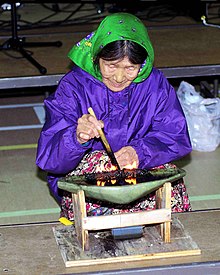This article has multiple issues. Please help improve it or discuss these issues on the talk page. (Learn how and when to remove these messages)
|

| Indigenous peoples in Canada |
|---|
 |
|
|
The Inuit are an indigenous people of the Arctic and subarctic regions of North America (parts of Alaska, Canada, and Greenland). The ancestors of the present-day Inuit are culturally related to Iñupiat (northern Alaska), and Yupik (Siberia and western Alaska),[1] and the Aleut who live in the Aleutian Islands of Siberia and Alaska. The term culture of the Inuit, therefore, refers primarily to these areas; however, parallels to other Eskimo groups can also be drawn.
The word "Eskimo" has been used to encompass the Inuit and Yupik, and other indigenous Alaskan and Siberian peoples,[2][3][4] but this usage is in decline.[5][6]
Various groups of Inuit in Canada live throughout the Inuvialuit Settlement Region of the Northwest Territories, the territory of Nunavut, Nunavik in northern Quebec and Nunatsiavut in Labrador and the unrecognised area known as NunatuKavut. With the exception of NunatuKavut these areas are sometimes known as Inuit Nunangat.
The traditional lifestyle of the Inuit is adapted to extreme climatic conditions; their essential skills for survival are hunting and trapping, as well as the construction of fur clothing for survival. Agriculture was never possible in the millions of square kilometres of tundra and icy coasts from Siberia to Northern America including Greenland. Therefore, hunting became the core of the culture and cultural history of the Inuit. They used harpoons and bows and arrows to take down animals of all sizes. Thus, the everyday life in modern Inuit settlements, established only some decades ago, still reflects the 5,000-year-long history of a hunting culture which allowed the Inuit and their ancestors to populate the Arctic.
- ^ "Inuit", Canadian Encycloprdia
- ^ "Eskimo | Definition, History, Culture, & Facts". Encyclopedia Britannica. 7 July 2023.
- ^ Hersher, Rebecca (24 April 2016). "Why You Probably Shouldn't Say 'Eskimo'". NPR. Retrieved 2021-04-01.
- ^ "Eskimo: Websters Dictionary". Retrieved 1 April 2021.
- ^ Kaplan, Lawrence. "Inuit or Eskimo: Which name to use?". Alaska Native Language Center, University of Alaska Fairbanks. Retrieved 2021-04-01.
- ^ "Expert says 'meat-eater' name Eskimo an offensive term placed on Inuit". Retrieved 2021-04-01.